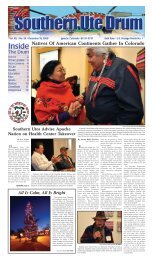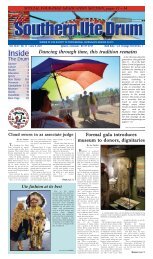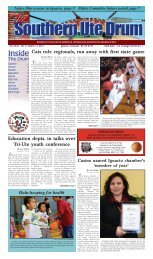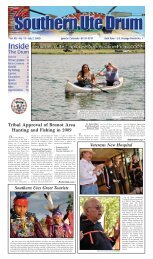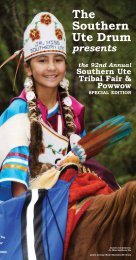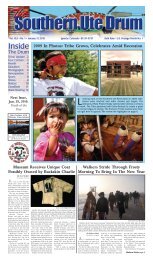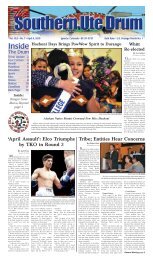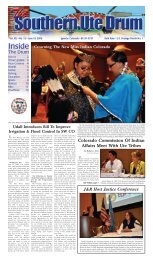December 30, 2010 - Southern Ute Indian Tribe
December 30, 2010 - Southern Ute Indian Tribe
December 30, 2010 - Southern Ute Indian Tribe
You also want an ePaper? Increase the reach of your titles
YUMPU automatically turns print PDFs into web optimized ePapers that Google loves.
<strong>December</strong> <strong>30</strong>, <strong>2010</strong><br />
Health Wh-chu-wiini (4)<br />
The Kidney Corner:<br />
Erythropoeitin: The “Wonder Drug”<br />
By Dr. Mark Saddler<br />
Durango Nephrology Associates<br />
Anemia, a decrease in the red<br />
blood cell count, is a major problem<br />
for patients with advanced<br />
chronic kidney disease. The main<br />
cause of this anemia is a decrease<br />
in a hormone which is normally<br />
produced by the kidneys, called<br />
erythropoietin (EPO for short).<br />
This hormone stimulates the bone<br />
marrow to increase production of<br />
new red blood cells.<br />
Before the late 1980’s, patients<br />
with End Stage Kidney Disease<br />
suffered greatly from the effects<br />
of anemia. The decrease in red<br />
blood cells limits oxygen delivery<br />
to the body’s tissues, resulting in<br />
fatigue, weakness and damage to<br />
heart muscle leading to heart failure.<br />
The anemia often had to be<br />
treated with blood transfusions<br />
and over time this led to total<br />
body iron overload, causing further<br />
problems with the heart, liver<br />
and joints. As a young doctor in<br />
training at that time, I remember<br />
well how much suffering this<br />
caused for my patients. However,<br />
in 1989, a synthetic form of EPO<br />
became available and this has revolutionized<br />
the care of patients<br />
with anemia due to chronic kidney<br />
disease. This drug, with the<br />
trade name “Epogen”, “Procrit”<br />
By Tim Heydinger<br />
<strong>Southern</strong> <strong>Ute</strong> Tribal Court<br />
Marijuana is a drug that is<br />
regulated by the Federal<br />
Controlled Substances Act.<br />
Possessing marijuana is a violation<br />
of federal law. However, rarely are<br />
people prosecuted for possessing<br />
small amounts of marijuana.<br />
Colorado has legalized the possession<br />
of marijuana for medicinal<br />
use. If a physician prescribes<br />
marijuana for a patient, the<br />
patient may then apply for a<br />
medical marijuana card. Once<br />
the person obtains the card, they<br />
can buy marijuana from a<br />
licensed dispensary. The person<br />
then will not be prosecuted by<br />
the state for possessing small<br />
amounts of, or using, marijuana.<br />
The <strong>Southern</strong> <strong>Ute</strong> <strong>Indian</strong> <strong>Tribe</strong><br />
has not legalized the possession of<br />
and a similar form of EPO called<br />
“Aranesp” are given by injection<br />
and stimulate production of red<br />
blood cells in the same manner<br />
that the natural hormone does.<br />
For patients on hemodialysis, the<br />
drug is usually given during the<br />
dialysis procedure, so no separate<br />
injection is needed. Patients on<br />
peritoneal dialysis, and the occasional<br />
patient who needs EPO but<br />
is not on dialysis, need to take a<br />
separate subcutaneous (under the<br />
skin) injection, typically about<br />
once per week.<br />
Most patients on EPO do not<br />
have problems getting their red<br />
blood cell pigment (hemoglobin)<br />
up. The dose needs to be monitored,<br />
however, to prevent the<br />
hemoglobin level climbing too<br />
high. There have been reports<br />
that some athletes have abused<br />
EPO to raise their hemoglobin<br />
level to try to enhance their performance.<br />
This practice is illegal<br />
and is grounds for suspension<br />
from athletic activities. It was<br />
suspected that this illegal use of<br />
EPO caused medical problems,<br />
for example strokes.<br />
For many years we were<br />
unsure what level of hemoglobin<br />
to strive for in patients with<br />
chronic kidney disease. Clearly,<br />
we want to alleviate the symptoms<br />
and complications related<br />
to anemia, but how much EPO is<br />
too much? Fortunately during<br />
<strong>2010</strong> we got some answers from<br />
a series of trials which addressed<br />
this question. The results of these<br />
clinical studies were similar to<br />
each other: when the hemoglobin<br />
level was pushed too high, there<br />
was an increased risk of heart<br />
attacks and strokes. This realization<br />
has led to a decrease in the<br />
target level for hemoglobin in<br />
chronic kidney disease patients<br />
treated with EPO. For those<br />
interested in the numbers, the<br />
target level for hemoglobin is<br />
now usually from 10 to 12 g/dl.<br />
We attempt to keep the hemoglobin<br />
within these limits by checking<br />
the hemoglobin level every<br />
1-2 weeks, making frequent<br />
adjustments in the EPO dose.<br />
Medical Marijuana and Tribal Law<br />
marijuana for any reason. Under<br />
tribal law, any Native American<br />
found on the Reservation with a<br />
drug regulated by the Federal<br />
Controlled Substances Act – such<br />
as marijuana – is subject to Tribal<br />
prosecution. The possession of a<br />
state-issued medical marijuana card<br />
is not a defense to the Tribal prosecution,<br />
just at the possession of a<br />
medical marijuana card would not<br />
be a defense to federal prosecution.<br />
The inconsistency between<br />
Tribal and state law presents problems.<br />
Native Americans can be<br />
(and are being) prosecuted by the<br />
<strong>Tribe</strong> for possessing a doctor-prescribed<br />
medication (marijuana),<br />
whereas non-Native people are<br />
not. The problem is exacerbated<br />
within the Ignacio town limits<br />
where the <strong>Tribe</strong> and the state have<br />
concurrent criminal jurisdiction.<br />
Some people are being prosecuted,<br />
and others are not, based solely<br />
on their ethnic origin (Native<br />
versus non-Native).<br />
The inconsistency also presents<br />
problems for people currently on<br />
probation through the Tribal<br />
Court. It is a standard condition<br />
of probation that the probationer<br />
not use or possess illegal drugs.<br />
Does a person violate the conditions<br />
of their probation if they use<br />
/ possess marijuana in conformity<br />
with state law off the reservation,<br />
even though the use / possession<br />
of marijuana is illegal if it happens<br />
on the reservation?<br />
At some point the <strong>Tribe</strong> must<br />
address these issues. Until that<br />
happens, it is a crime to possess<br />
marijuana on the Reservation,<br />
and the possession of a valid<br />
state-issued medical marijuana<br />
card is not a defense to the Tribal<br />
prosecution.<br />
Elders’ Speak Conference:<br />
Meeting Community Needs<br />
By Arlene A. Millich<br />
Our Sister’s Keeper Coalition<br />
Board Member<br />
Diane Millich, of Our<br />
Sister’s Keeper Coalition<br />
(OSKC), Louanna Worrell and<br />
Lori Thompson of Healing<br />
Hearts, Cortez, met and brainedstormed<br />
to define the needs of<br />
the people from the <strong>Ute</strong><br />
Mountain/Cortez vicinity. They<br />
determined who: best could give<br />
good advice, are respected members<br />
of their respective communities,<br />
have lived through abuses<br />
and came up with - why not have<br />
the elders speak to us.<br />
The 1st Annual Elders’ Speak<br />
Conference held at the<br />
Montezuma Cortez Annex on<br />
<strong>December</strong> 17, <strong>2010</strong> was well<br />
attended by approximately 70<br />
people. The majority of the attendees<br />
were <strong>Ute</strong> Mountain <strong>Ute</strong>s.<br />
The focus of the conference was:<br />
“Elders Speak: How we survived<br />
alcohol/substance abuse and<br />
domestic violence and the information<br />
we want to share with<br />
you, as elders, is.”<br />
Mayor of Cortez, Dan Porter;<br />
and <strong>Southern</strong> <strong>Ute</strong><br />
Councilwoman, Joycelyn<br />
Dutchie were on hand to welcome<br />
the participants. Missing<br />
were the <strong>Ute</strong> Mountain <strong>Ute</strong> council<br />
members, who agreed to<br />
assist, but were attending a very<br />
important meeting with President<br />
Obama in Washington, D.C.<br />
However, many <strong>Ute</strong> Mountain<br />
<strong>Ute</strong> tribal members stepped up to<br />
do the welcome, prayers and<br />
songs. A wonderful attribute of<br />
having the conference in the<br />
Cortez area is that many tribal<br />
members are available to pray,<br />
drum and give thanks to our<br />
Creator and so do Willingly.<br />
Those Natives participating in<br />
prayers and songs were: Boyd<br />
Lopez, Jerald Peabody, Danny<br />
Clark, Betty Howe, Karen<br />
Artichoker, Mr. Suma and Jeff,<br />
from Canada.<br />
Two panels made up of Dine,<br />
<strong>Southern</strong> <strong>Ute</strong>s, <strong>Ute</strong> Mountain<br />
<strong>Ute</strong>s, Canadians and Non-<br />
Natives were present to share<br />
their life stories and how they<br />
survived substance abuse and<br />
domestic violence, in the hopes<br />
that their wisdom would reverberate<br />
and penetrate into minds<br />
and hearts of their family, children<br />
and friends.<br />
The stories took different<br />
paths: from scars of the Vietnam<br />
War and the over<br />
abundance/availability of alcohol<br />
and drugs in the military; early<br />
alcoholism; early childhood<br />
introduction to drugs; living life<br />
in drug-infested communities;<br />
living with abusive husbands,<br />
boyfriends; living with abusive<br />
foster families; and abuses in the<br />
Bureau of <strong>Indian</strong> Affairs<br />
Schools.<br />
In spite of the abuses, which<br />
occurred in the elders’ lives, the<br />
end result was healing, forgiveness<br />
and living a life without<br />
regrets. Living in the past can<br />
only result in selfinjury, selfdefeat<br />
and vengeance. Most presenters<br />
talked about their relationship<br />
with their Creator and<br />
how this relationship turned their<br />
lives around: AA Big Book and<br />
religious organizations.<br />
Research show domestic violence<br />
and substance abuse are cooccurring<br />
behaviors. Until both<br />
behaviors are addressed, the<br />
cycle of violence will continue<br />
for generations. There is a high<br />
correlation between drug/substances<br />
and domestic violence,<br />
especially in Native communities.<br />
The higher the incidence of<br />
alcohol/drug use, the higher rate<br />
of domestic violence, this concept<br />
was further explained by the<br />
keynote speaker Karen<br />
Artichoker. Karen, a Sioux<br />
<strong>Indian</strong>, is a former co-founder<br />
ofCangleska, Inc., a comprehensive<br />
domestic violence and substance<br />
abuse prevention and<br />
intervention program on the Pine<br />
Ridge reservation. Karen was the<br />
director of Sacred Circle, which<br />
was under the auspices of<br />
Cangleska. Sacred Circle is a<br />
national resource center dedicated<br />
to end violence against<br />
women, by providing technical<br />
assistance and consultation to<br />
<strong>Indian</strong> tribes and programs.<br />
Today, Karen is substance abuse<br />
counselor for the in-patient<br />
“meth” program on the Rosebud<br />
Sioux reservation.<br />
Karen said, “In the past, tribal<br />
communities saw women as<br />
sacred beings and treated them<br />
accordingly - this stopped with<br />
colonization. The colonists<br />
brought the concept to the<br />
Americas that women were chattel,<br />
thus, owned by their fathers<br />
and husbands. These men could<br />
do with the women whatever<br />
they wanted. Women were treated<br />
as second class citizens, thus,<br />
an attitude which men held,<br />
resulted in: male privilege and<br />
dominance, rape, marriage rape,<br />
incest, shame, battering, elder<br />
abuse, loss of language, loss of<br />
rituals and spiritual confusion.<br />
The most insidious result was the<br />
dehumanization and demonization<br />
of Native Women. Today<br />
Native women face the highest<br />
rates of domestic violence and<br />
sexual abuse (l out of every 4<br />
women will be sexual abused).”<br />
Federal dollars are being given<br />
to Native communities to assist<br />
in developing programs for the<br />
eradication of violence against<br />
Native women. This continues to<br />
be an on-going problem and may<br />
take several generations to gain<br />
back the notion that Native<br />
women are sacred. A good start<br />
is to stop abusing alcohol/substances<br />
and start looking at your<br />
female counterparts through loving<br />
and compassionate eyes.<br />
Diane Millich said, “While<br />
abuse is rampant on Native reservations,<br />
the abuse is also felt by<br />
males. Males are traumatized by<br />
domestic/sexual violence and<br />
have statistics similar to Native<br />
women (l out of every 6 males<br />
will be sexual abused). It must be<br />
recognized that these abuses will<br />
continue to occur on Native<br />
reservations as long as we do not<br />
bring them to the forefront. Many<br />
Natives suffer from Post<br />
Traumatic Stress Disorder<br />
(PTSD), a psychological diagnosis<br />
associated with war victims.<br />
It will take strong people to delve<br />
into their psychic and reveal, for<br />
their families, the secrets they<br />
have kept hidden for generations.<br />
The future for Natives will<br />
brighten when we take responsibility<br />
for eradicating domestic<br />
offenders and sexual predators<br />
from our reservations or at the<br />
very least, bring them to justice.”<br />
The elders shared the following<br />
information: be good listeners;<br />
maintain harmony by focusing<br />
on the bio-psycho-social and<br />
emotional areas of your life; take<br />
responsibility and be accountable<br />
for what you do; smile and have<br />
humor in your lives, think positively;<br />
find outlets to help you<br />
overcome your tragedies, such as<br />
AA, Alanon, therapy, church;<br />
teach your children about substance<br />
abuse and domestic violence,<br />
especially if you were<br />
raised in that environment; help<br />
one another by reaching out; use<br />
alternative medicine or therapies<br />
for healing; use tribal healers and<br />
traditional methods for wellness;<br />
be grateful for what you have;<br />
ask for forgiveness and make<br />
amends; come to the realization<br />
that you don’t have to live with<br />
violence; and lastly - create a<br />
relationship with your Creator<br />
and develop a strong sense of<br />
spiritualism.<br />
Overall the conference was<br />
deemed a success and will continue<br />
to be an annual event.<br />
Youth<br />
Basketball<br />
Registration is closed for youth<br />
basketball. Opening Ceremonies<br />
for 2011 youth basketball will be<br />
Jan. 8 at 9 a.m. Teams will be<br />
introduced in their uniforms,<br />
there will be contests and prizes,<br />
and the season opener games<br />
will start at 10 a.m. Hope to see<br />
you all there!<br />
If you have any questions or<br />
concerns, please call the front<br />
desk at 970-563-0214.<br />
Sun<strong>Ute</strong><br />
New Year’s Eve<br />
Hours<br />
New Years Eve<br />
Friday, Dec. 31<br />
10 am - 2 pm<br />
New Years Day<br />
Saturday, Jan. 1<br />
10 am - 2 pm<br />
Sun<strong>Ute</strong> will resume<br />
normal hours on<br />
Sunday, Jan. 2



